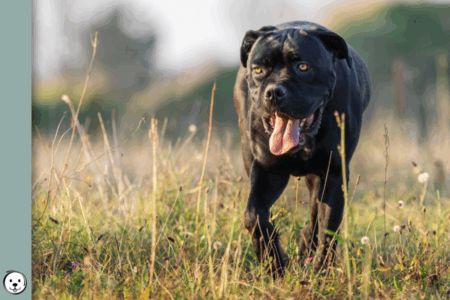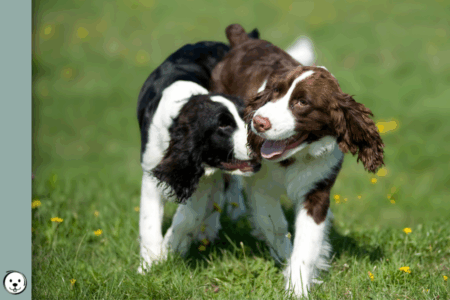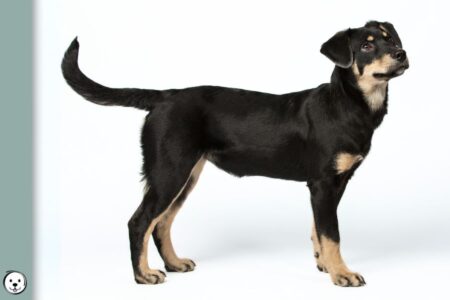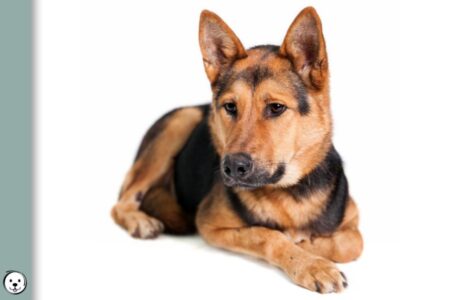Learn all about the different Cane Corso coat colors.
Table of Contents
Cane Corso Standard Colors
The colors listed by the AKC and FCI in their breed standards. The Cane Corso is not yet recognized by the Kennel Club, meaning there’s no official breed standard in the UK.
“Acceptable colors are black, lighter and darker shades of gray, lighter and darker shades of fawn, and red. Brindling is allowed on all of these colors. Solid fawn and red, including lighter and darker shades, have a black or gray mask. The mask does not go beyond the eyes.“
AKC Breed Standard[1]
“Black, lead-grey (blue), slate-grey (blue), light grey (blue), light fawn; dark fawn and stag red; dark wheat colour; black brindle, grey (blue) brindle, in brindle dogs fawn stripes can be of different shades; in fawn and brindle dogs the black or grey (blue) mask on the muzzle should not go beyond the line of the eyes.“
FCI Breed Standard[2]
Cane Corso Color Chart
Check out this Cane Corso color chart:
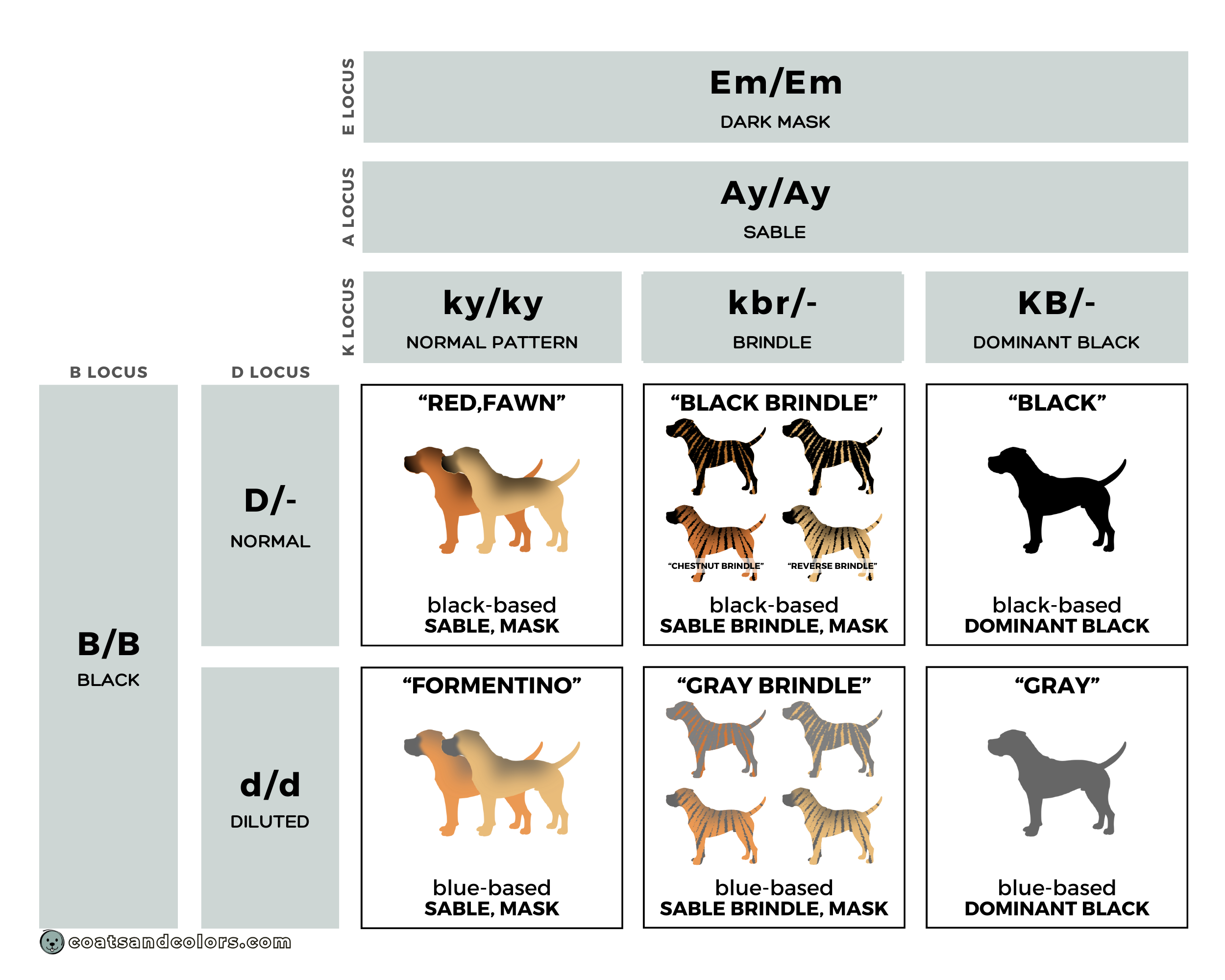
Cane Corso Coat Type
The coat type can significantly affect how we perceive coat colors.
The Cane Corso is a short-haired (L/L) dog breed.
However, the long coat (l) variant also occurs at very low frequencies. Breeding two carriers (L/l) is unlikely but may produce a fluffy Corso puppy (l/l)[3].
Some Cane Corso dogs may test positive for having a curly allele. However, curly coat can only express in long-haired dogs, so there is no reason to select against it in short-haired breeds.
Cane Corso Standard Colors
Cani Corsi have three accepted patterns: solid dark, masked sable, or masked sable brindle. Each pattern can come with either black or blue eumelanin and fawn or red phaeomelanin intensity.
All patterns can have small white markings.
Some more details on standard colors in this breed:
Black Cane Corso
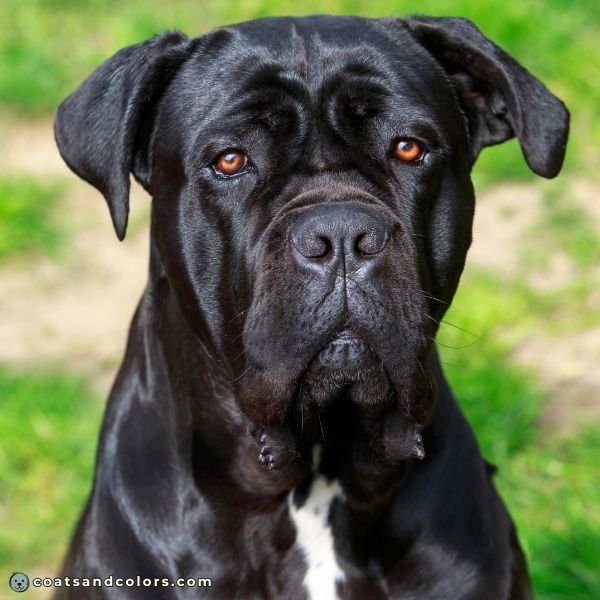
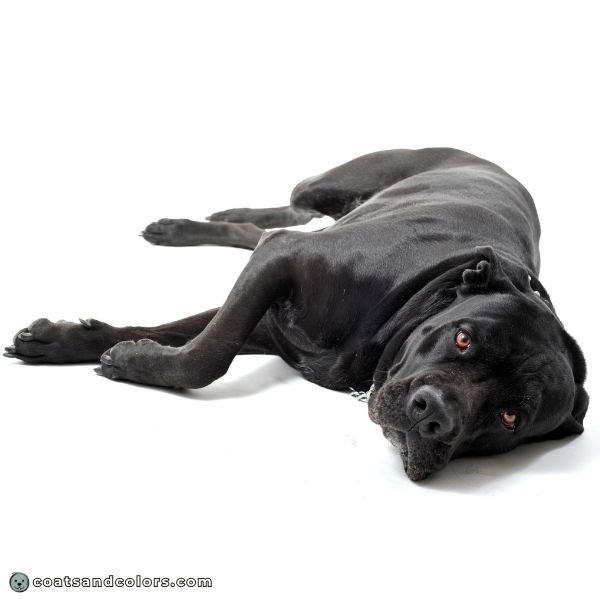
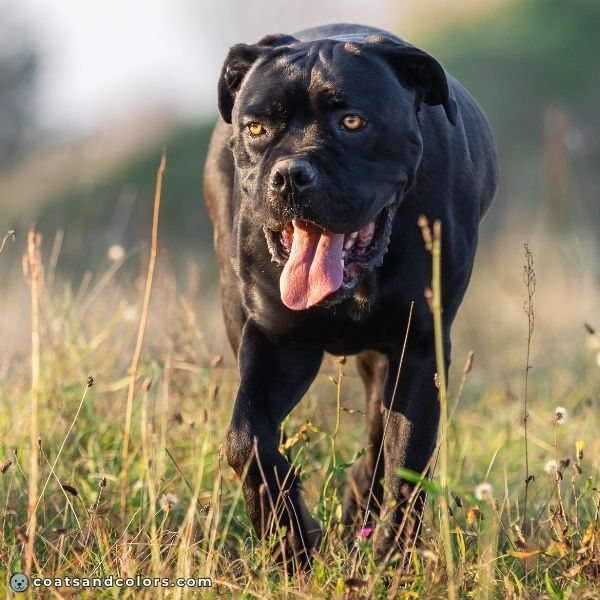
Eumelanin:
black-based pattern (B/B D/-)
Phaeomelanin:
none
Base Pattern:
dominant black (Ay/- KB/- Em/-)
recessive black (a/a kbr/- or ky/ky)
White:
solid
minimal white
Most Cane Corso have sable (Ay/-) at their A locus. But it doesn’t really matter since the dominant black pattern (KB/-) hides the A locus pattern and replaces it with a solid black coat. All Cane Corso are supposed to have a mask (Em/-). But a black mask will not be visible on an already black dog.

Some KB/- dogs might be seal. This is an untestable trait where the red pigment from the hidden Ay pattern bleeds through the solid black coat. Another term for a seal phenotype could be ghost sable.

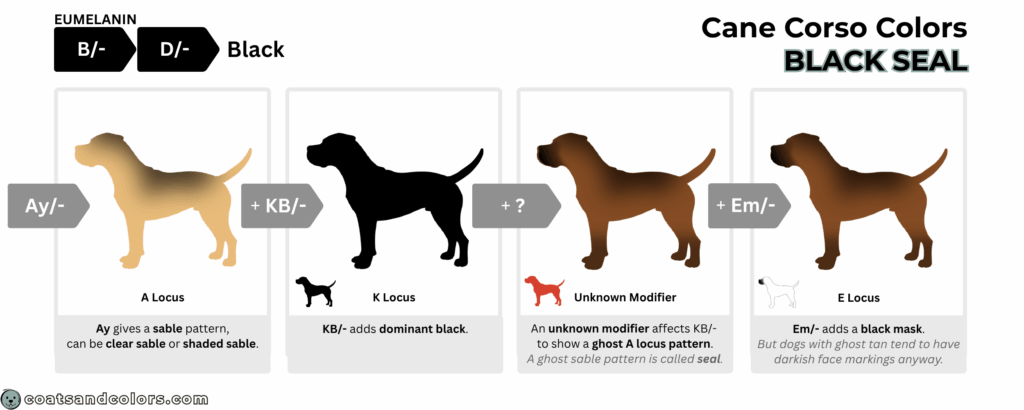
Some seal dogs might even show the faintest hint of ghost brindle if they are seal and KB/kbr.
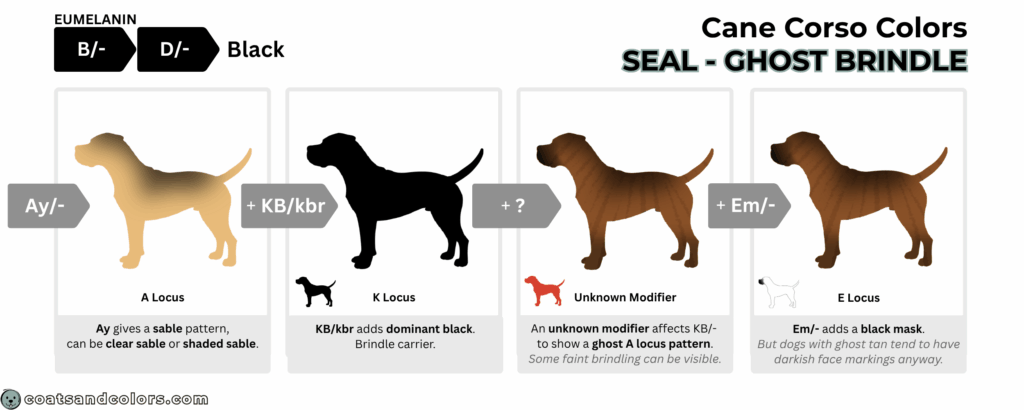
A black dog can, in theory, also be recessive black (ky/ky a/a or kbr/- a/a). But this is very rare and will often go unnoticed unless the solid puppy was born from two fawn and/or brindle parents.
A 2019 study reported the allele frequency of a for a small sample of Cane Corso dogs as about 1%[3]. So the recessive black allele has been confirmed for this breed. It’s just very rare.

Gray Cane Corso
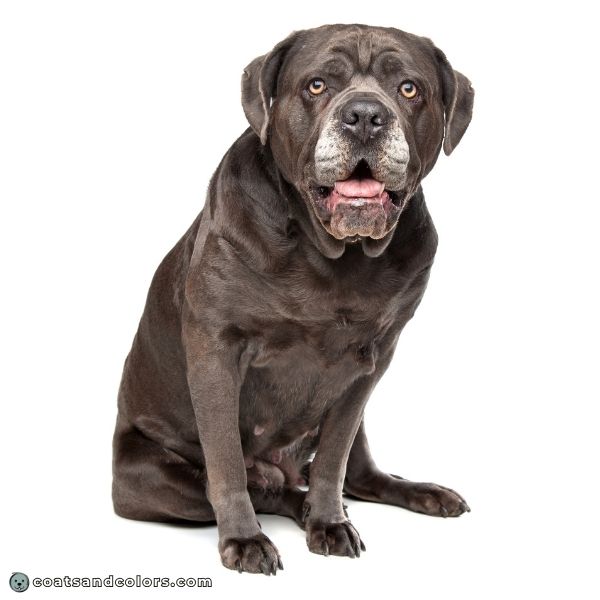
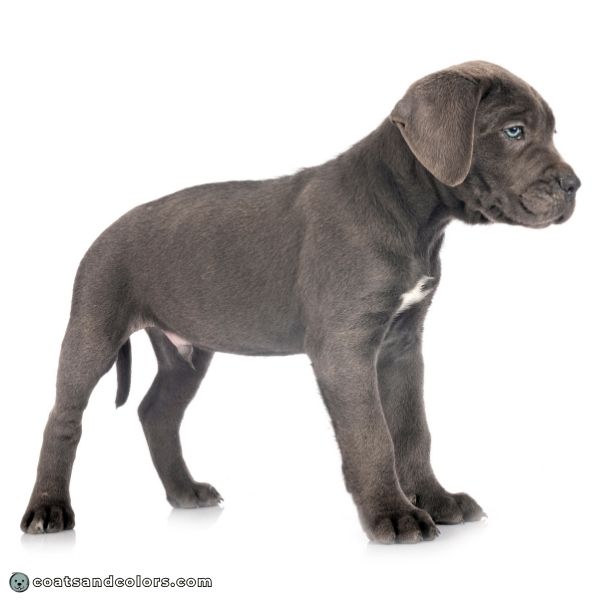
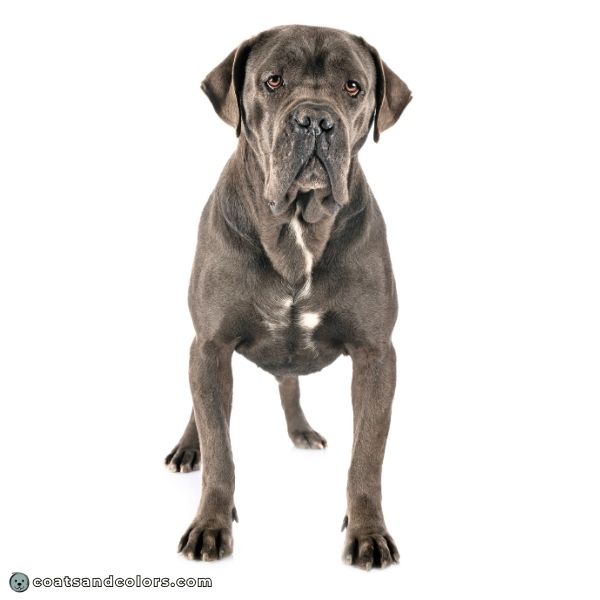
Eumelanin:
blue-based “gray” pattern (B/B d/d)
Phaeomelanin:
none
Base Pattern:
dominant black (Ay/- KB/- Em/-)
recessive black (a/a kbr/- or ky/ky)
White:
solid
minimal white
Dogs with d/d have diluted eumelanin. The Cane Corso breed term for diluted black is “gray“, other breeds call it “blue“. This color ranges from dark charcoal to slate to lighter shades of gray. The FCI standard calls these variations of solid blue lead-grey, slate-grey, and light grey.
Most Cane Corso are sable (Ay/-). But it doesn’t really matter since the A locus pattern will be hidden. The dominant black pattern (KB/-) hides the A locus pattern and gives a solid dark coat. Most Cane Corso have a mask (Em/-). But a gray mask will not be visible on an already gray dog.

Some KB/- dogs might be “blue seal“. Seal is an untestable trait where the red pigment from the hidden Ay pattern bleeds through the solid gray coat. Another term for a seal pattern could be ghost sable.
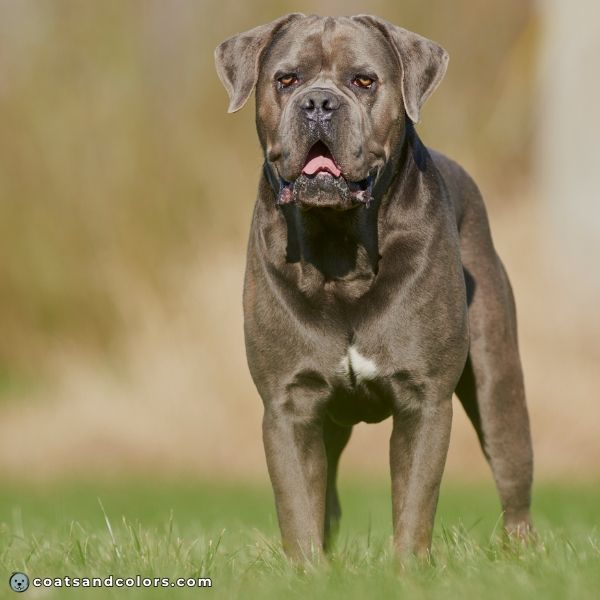
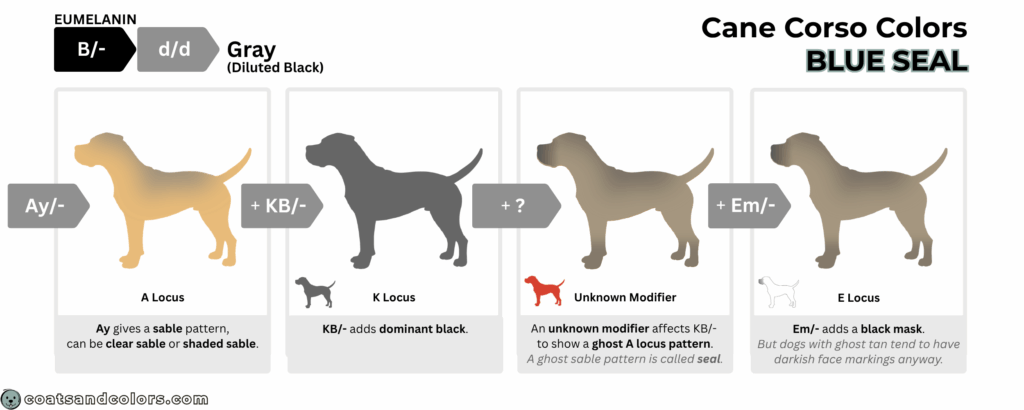
Some dogs can also have faint ghost brindle if they are seal and KB/kbr.
Ghost brindling can be very subtle with no real tan anywhere on the dog, just reddish ghost tan between the gray stripes. Otherwise, this is still a seal pattern with darker legs and darker coat along the topline.
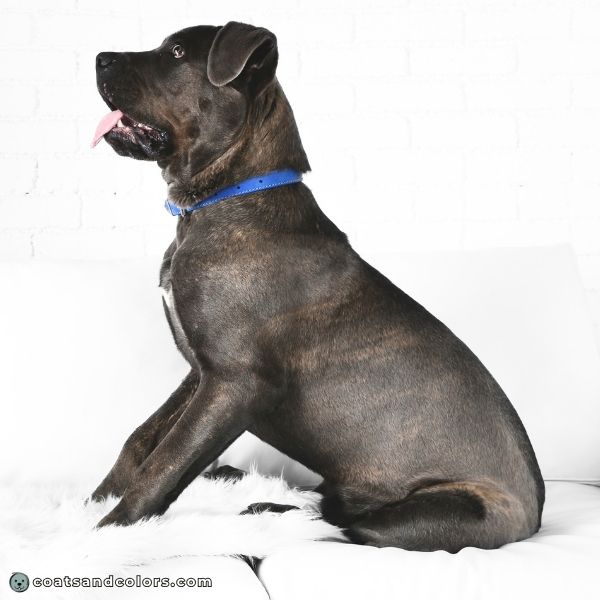
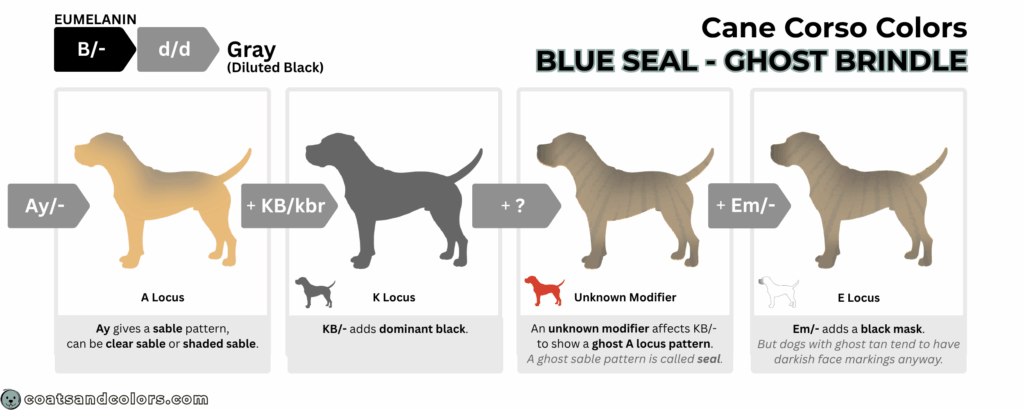
A dog with a gray coat can also be recessive solid (ky/ky a/a or kbr/- a/a). But again, this is incredibly rare and will only be noticed if a solid puppy is born only from fawn and/or brindle parents.
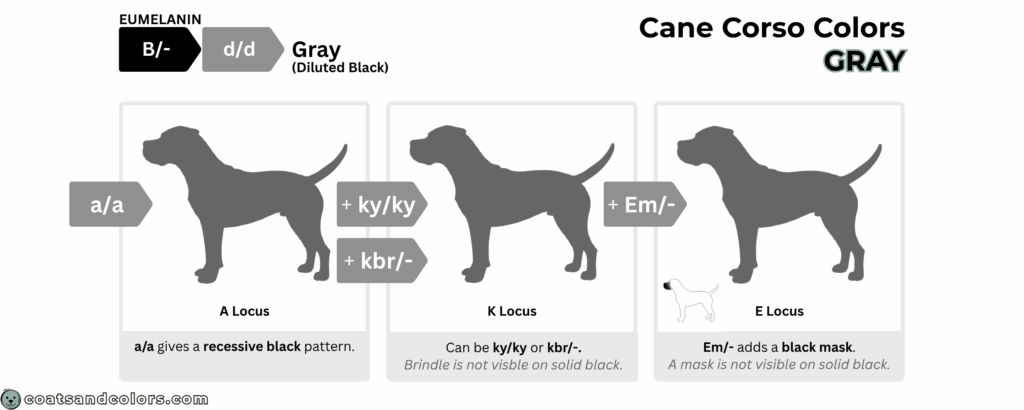
Fawn Cane Corso
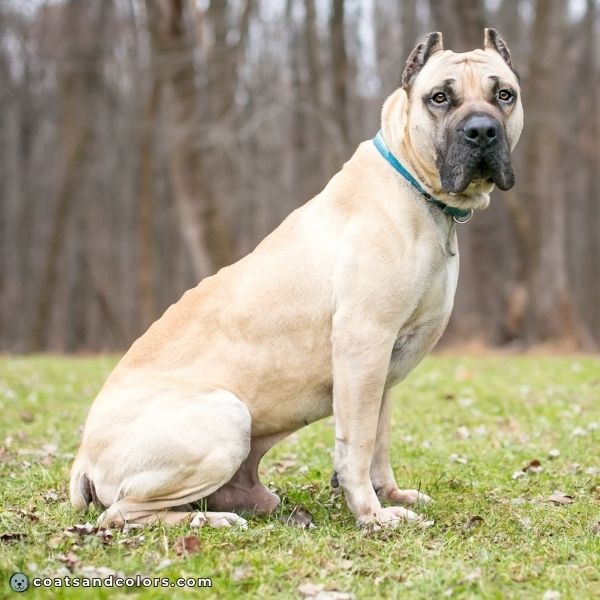
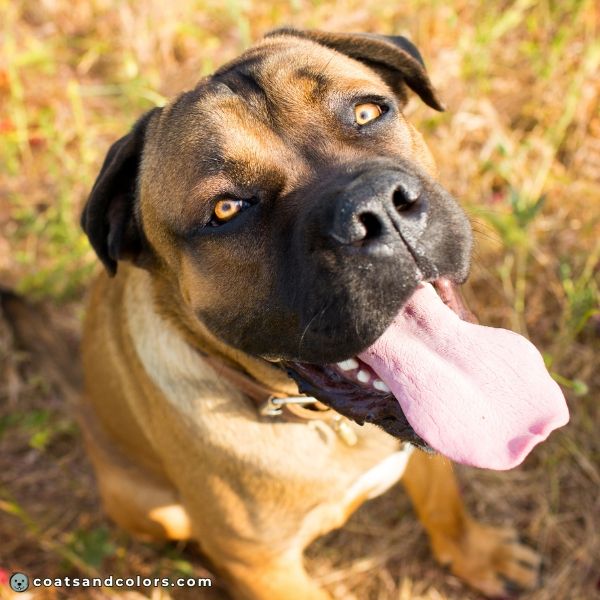
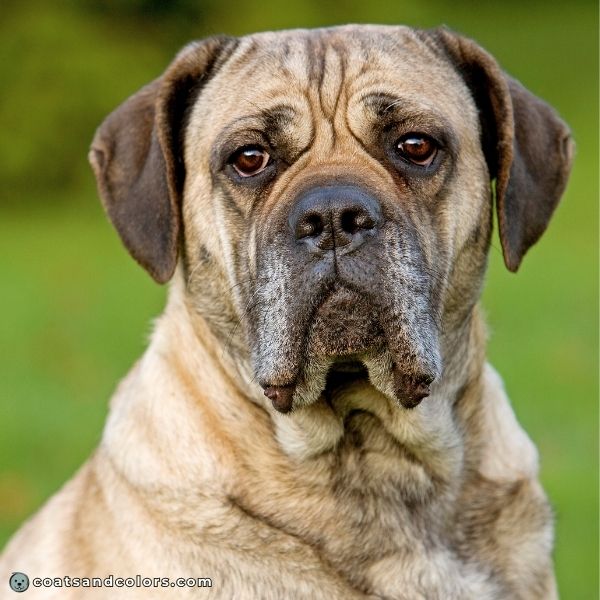
Eumelanin:
black-based pattern (B/B D/-)
Phaeomelanin:
“fawn“
Base Pattern:
sable, black mask (Ay/- ky/ky Em/-)
White:
solid
minimal white
A black-based sable is sometimes called “fulvo” in this breed, regardless of its red base color.
A fawn Cane Corso has a sable pattern (Ay/-). Some dogs are shaded sable with an overlay of black-tipped hairs on their top. The Cane Corso breed term for the black overlay or sabling is “carbon“.
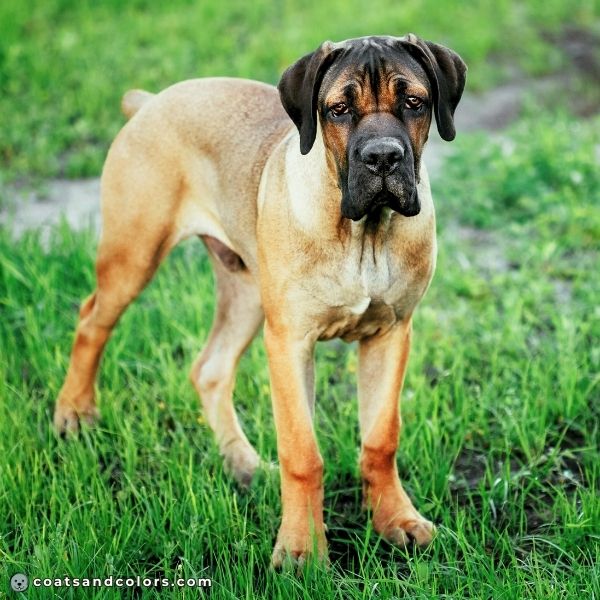
Heavy dark overlay can create the illusion of “false tan points“, especially in puppies. Denise Flaim from Modern Molosser has a great article with images that illustrate this phenotype.
The Cane Corso breed term for sable with low red intensity is “fawn“. The color of their phaeomelanin can vary from light fawn to dark fawn, from a wheaten or buff, to a blonde Cane Corso.
Normal A locus pattern expression requires a dog to be homozygous recessive ky/ky. A fawn Cane Corso is also meant to have a black mask (Em/-). The mask should not go beyond the eyes.

Red Cane Corso

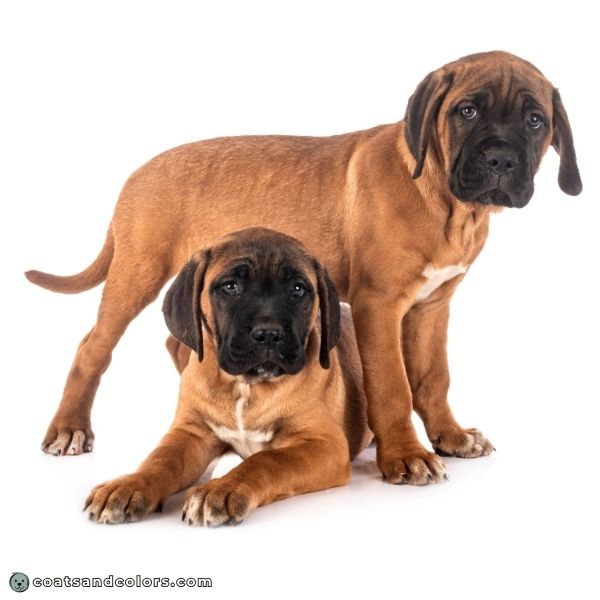
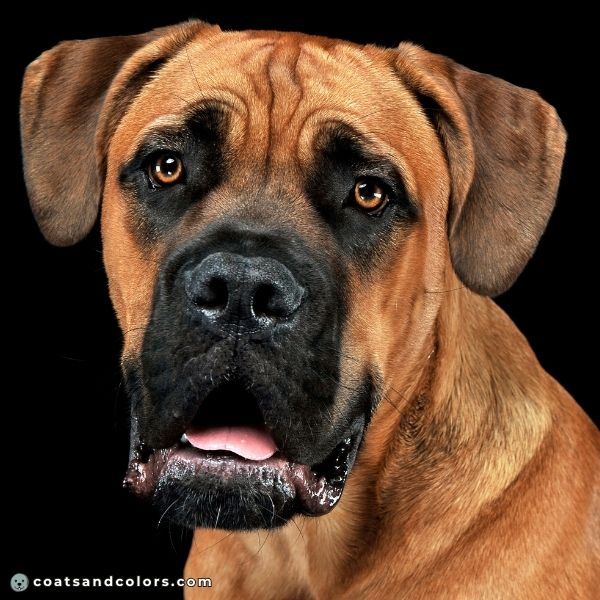
Eumelanin:
black-based pattern (B/B D/-)
Phaeomelanin:
“red“
Base Pattern:
sable, black mask (Ay/- ky/ky Em/-)
White:
solid
minimal white
A red Cane Corso has a sable pattern (Ay/-) with a black mask (Em/-). The only difference to a fawn dog is the more intense “stag red” base color. But a deep red color is somewhat rare in Cani Corso.
And it is a matter of opinion where exactly “dark fawn” turns into “red”.

Formentino Cane Corso
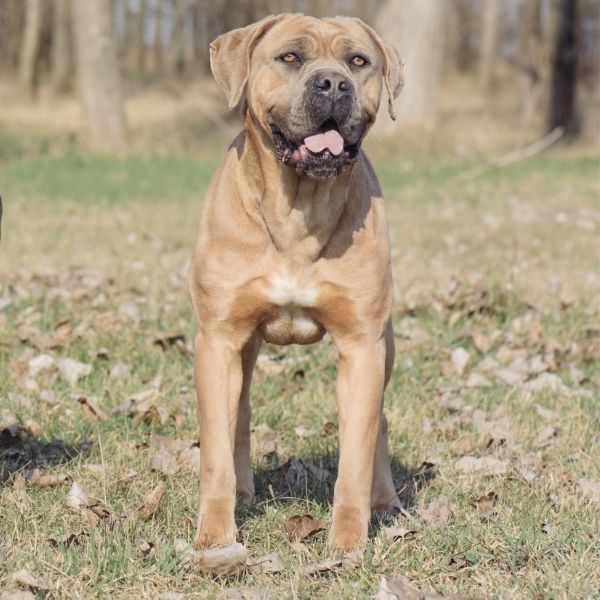
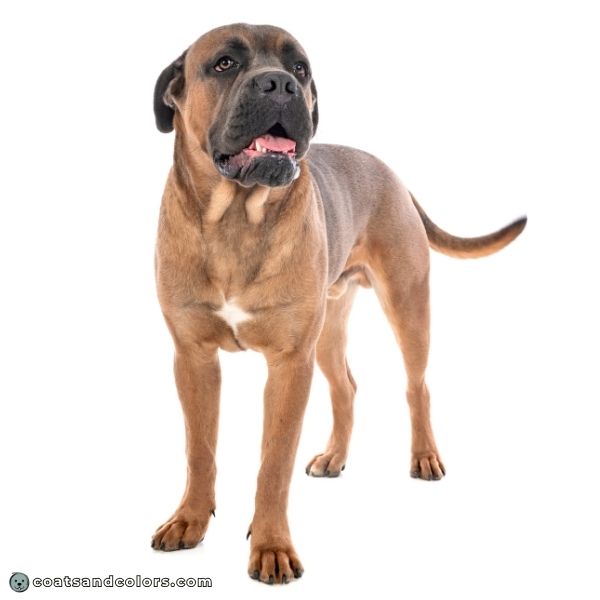
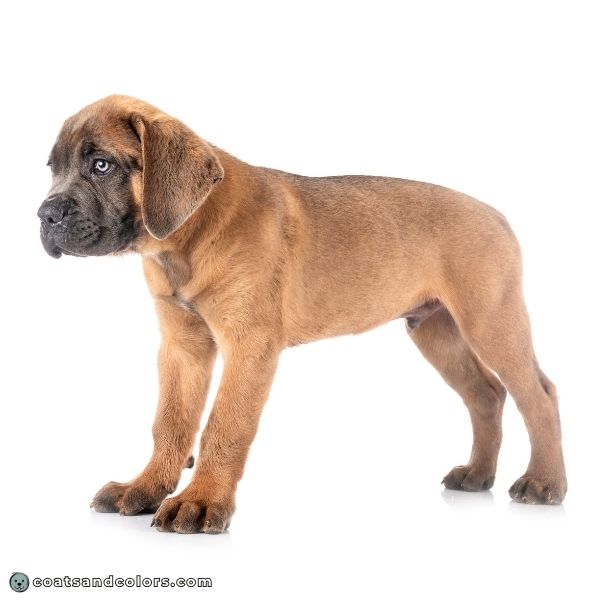
Eumelanin:
blue-based “gray” pattern (B/B d/d)
Phaeomelanin:
“fawn”, “red“
Base Pattern:
sable, gray mask (Ay/- ky/ky Em/-)
White:
solid
minimal white
The breed term for a blue-based fawn Cane Corso is “formentino“.
A formentino Cane Corso has a sable pattern (Ay/-). Any visible sabling or “carbon” will be light gray or dark gray. Normal A locus pattern expression requires a dog to be homozygous recessive ky/ky. A blue fawn Cane Corso has a gray mask (Em/-). The mask should not go beyond the eyes.
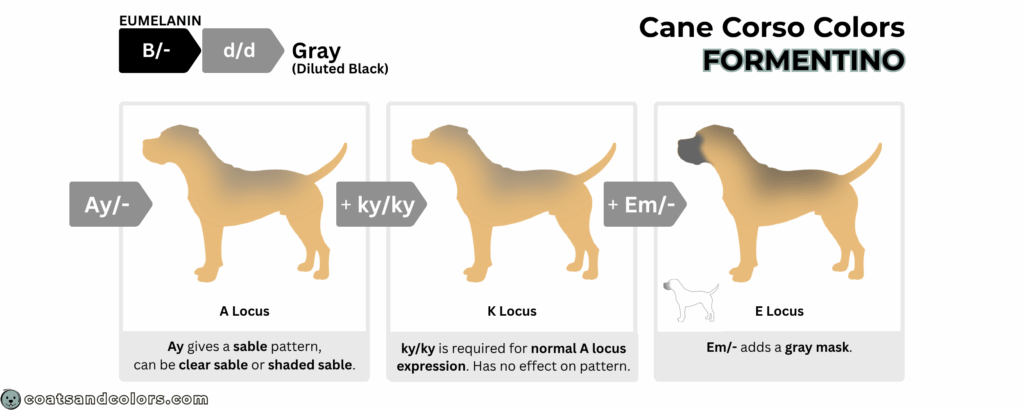
Black Brindle Cane Corso

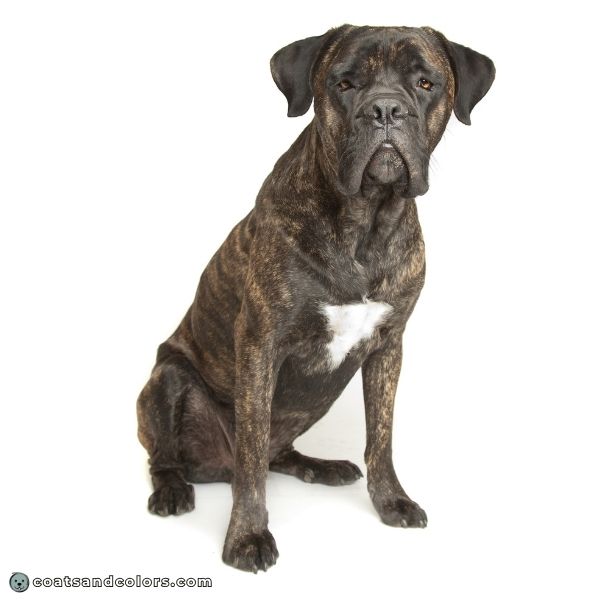

Eumelanin:
black-based pattern (B/B D/-)
Phaeomelanin:
“fawn”, “red“
Base Pattern:
sable brindle, black mask (Ay/- kbr/- Em/-)
White:
solid
minimal white
A black brindle Cane Corso has a sable pattern (Ay/-) with or without carbon. Brindled A locus pattern expression requires a dog to be kbr/-. The density of black brindling can be rather sparse or very heavy. The Cane Corso breed tends to be heavily brindled, making some dogs look almost solid black.
A black brindle Cane Corso has a black mask (Em/-). The mask should not go beyond the eyes.

The density of stripes can vary greatly among dogs. It is obvious that breeders can select dogs towards more pronounced brindling, but the causes of variation in brindle density are not yet fully understood.
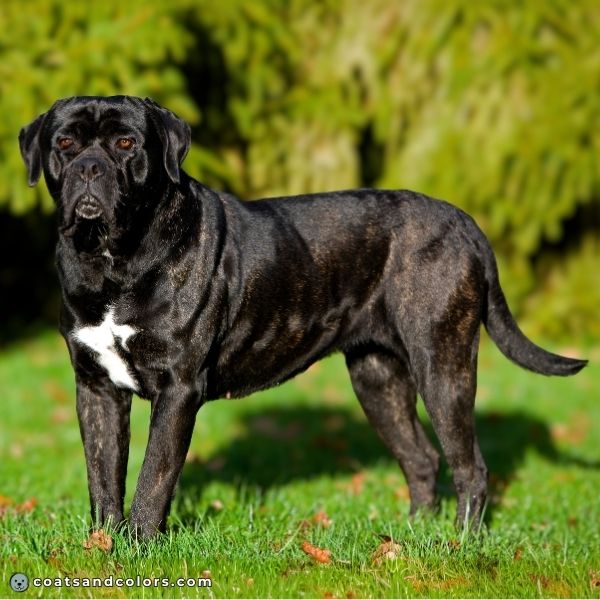
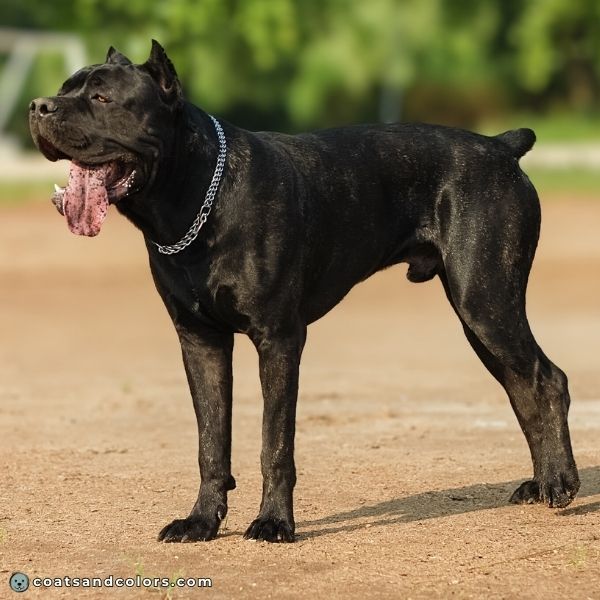
An only lightly brindled dog is sometimes referred to as a “reverse brindle”. But no matter how sparse or dense the brindle is, it is always black stripes on a fawn or red base and never the other way round!

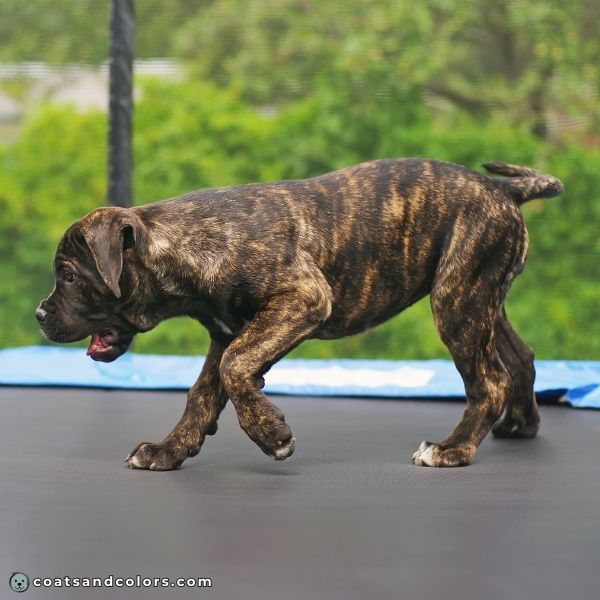

Chestnut Brindle Cane Corso
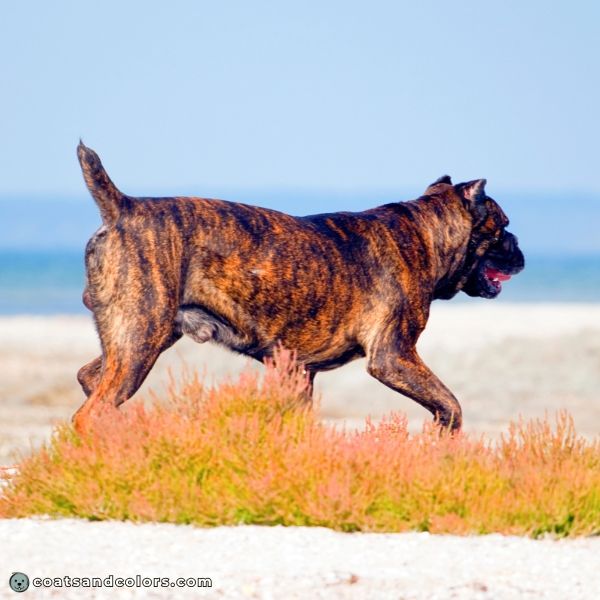
Eumelanin:
black-based pattern (B/B D/-)
Phaeomelanin:
“red“
Base Pattern:
sable brindle, black mask (Ay/- kbr/- Em/-)
White:
solid
minimal white
This is one of those breed terms without a clear definition. It hints at some sort of “reddish brindle”.
A chestnut brindle Cane Corso has a sable pattern (Ay/-) underneath the stripes. The brindled A locus pattern expression requires a dog to be kbr/-. A chestnut brindle Cane Corso has a black mask (Em/-).
Most of these dogs are basically “reverse black brindle” (which in this breed means “less brindle than average”) on a red base color. Chestnut brindle is just a twist on the common “black brindle” pattern.
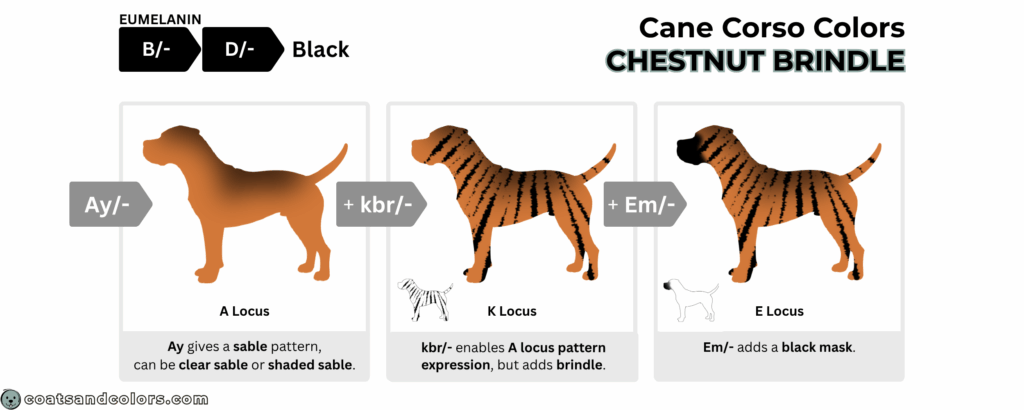
Ever since I first heard about this breed term, I have been convinced that at least some dogs with this pattern could actually be seal brindle. See, the unknown modifier that causes seal in KB/- dogs can also affect the black brindling in kbr/- dogs. Which is almost impossible to capture in images.
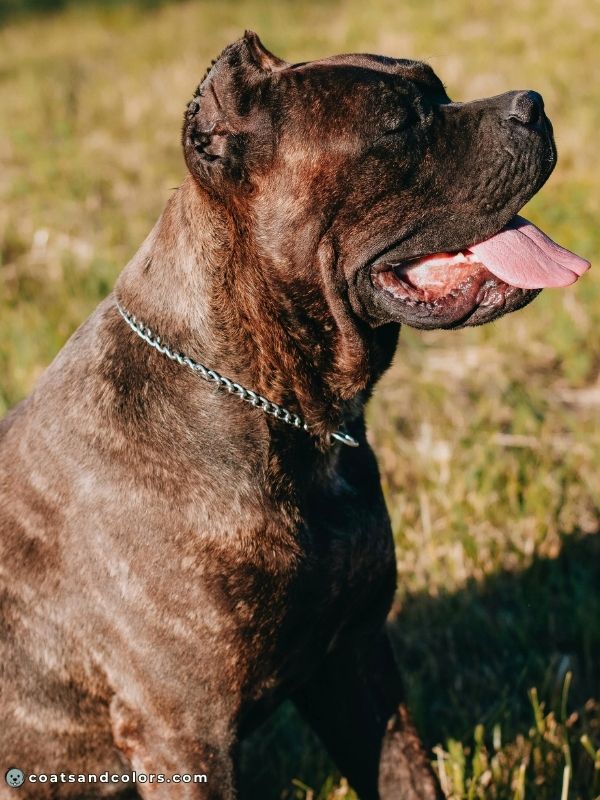
The unknown modifier turns the black striping on a seal brindle a little less opaque. The resulting tan bleed-through makes any black striping look coppery or brownish. This way, even a more heavily brindled dog may look a little reddish or “chestnut-colored” when viewed in direct sunlight.
The Modern Molosser blog has some more images for you.

Gray Brindle Cane Corso
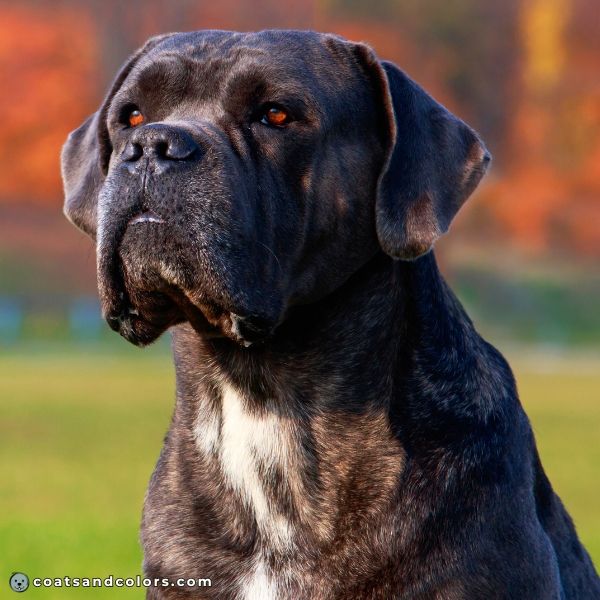
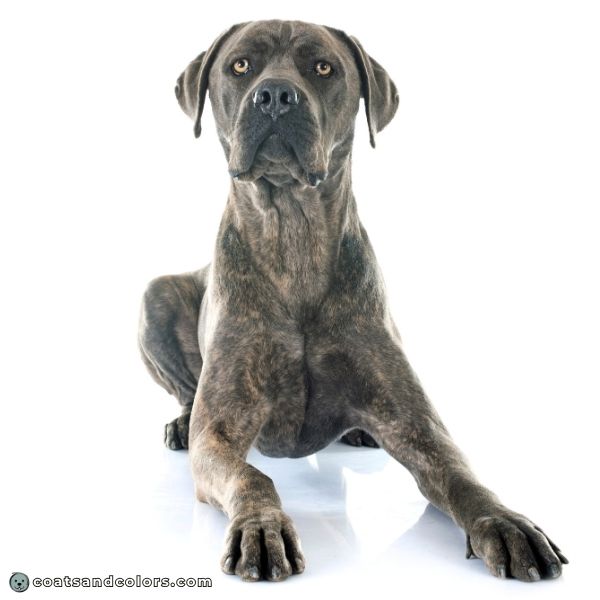
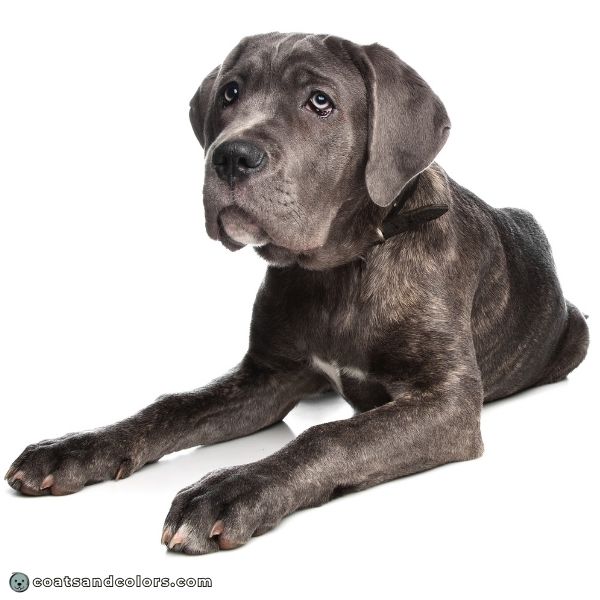
Eumelanin:
blue-based “gray” pattern (B/B d/d)
Phaeomelanin:
“fawn”, “red“
Base Pattern:
sable brindle, gray mask (Ay/- kbr/- Em/-)
White:
solid
minimal white
The breed term for a formentino Cane Corso with brindling is “gray brindle“.
A locus pattern expression with brindle requires a dog to be kbr/-. The density of gray brindling can be rather sparse or get heavy to the point where the dog looks almost gray. Some may call dogs with an uncommonly light brindle density “reverse blue brindle” but this is just another breed term.
A gray brindle Cane Corso also has a gray mask (Em/-) that should not go beyond the eyes.
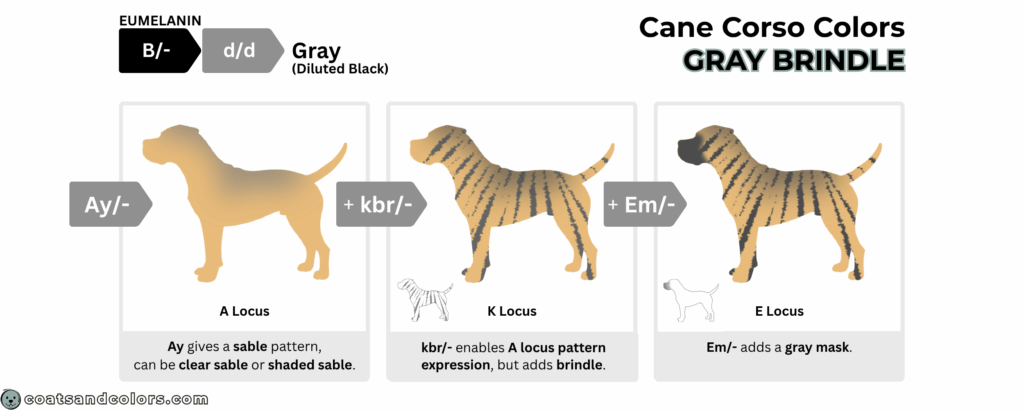
These dogs can have dense brindling and look almost solid gray. A dog with only moderate brindling and lots of visible tan is sometimes called a “reverse gray brindle“.
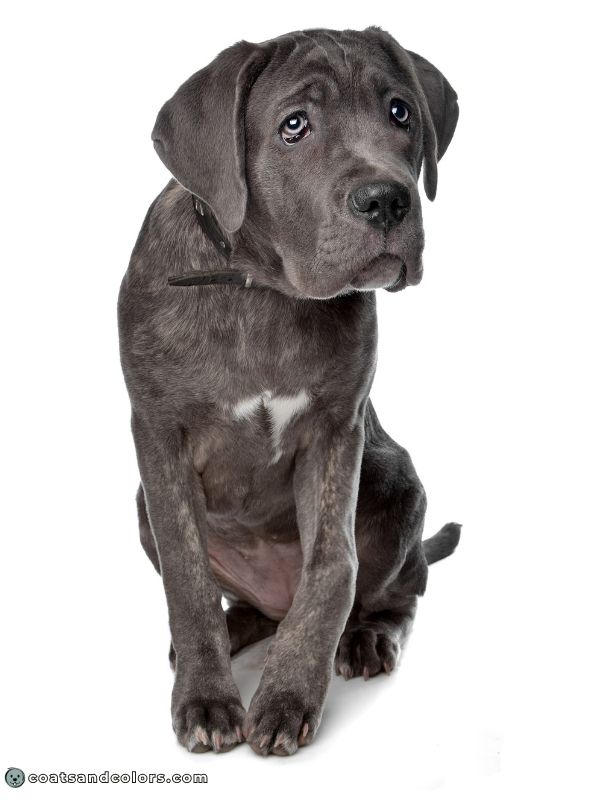
Cane Corso White Markings
“There may be a white patch on the chest, throat, chin, backs of the pasterns, and on the toes.”
AKC Breed Standard[1]
“A small white patch on the chest, on the tip of the toes and on the bridge of the nose is acceptable.
Disqualifying Faults: […] large white patches.”
FCI Breed Standard[2]
About all of these dogs are homozygous solid S/S at the S locus.
Not surprising, the allele frequency of the piebald variant sP is super low (about 1%) [3]. The actual amount of white in piebald carriers (S/sP) is controlled by untestable modifiers and can be very minimal.

A dog can still express residual white or white from other traits while still testing S/S (solid).
Any white a puppy shows at birth might fill in to a certain extent later on. Sometimes, small white markings (e.g., white toes) disappear completely. However, breeding two dogs that had a lot of white markings as puppies can increase the extent of residual white from generation to generation.
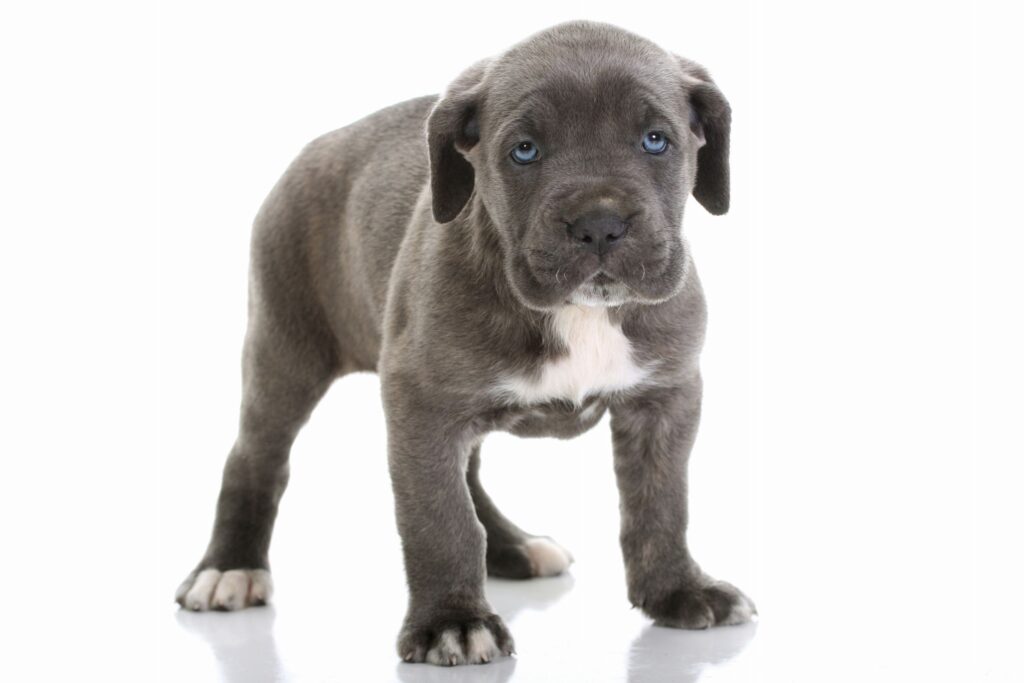
Small white patterns like a white chest spot are quite common in the Cane Corso breed.
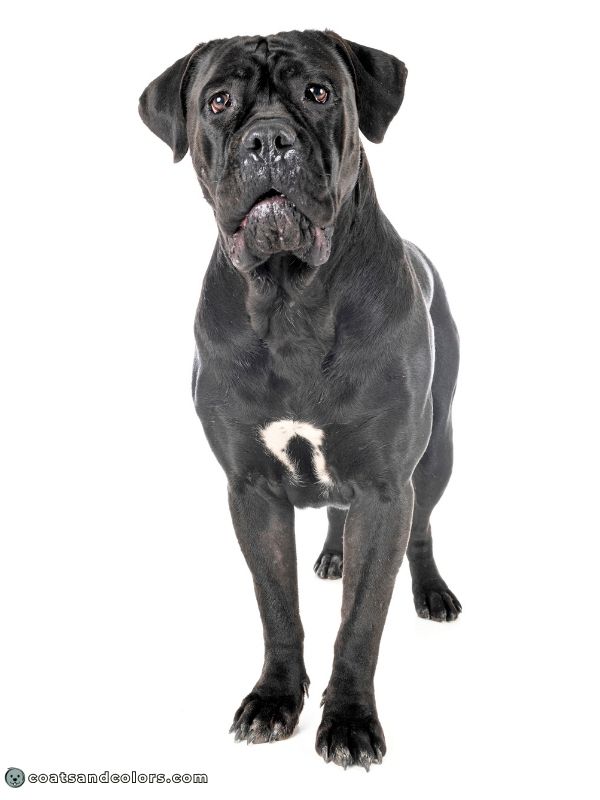
Some dogs have more noticeable white markings such as white paws or a larger white chest patch. Even some white on the chin, neck, chest, pasterns, belly, or bridge of the muzzle is common.
Cane Corso Eye Colors
“Dogs with black muzzles (coat colors of black, fawn or red, and these colors brindled) dark brown eyes are preferred.
Gray muzzles (coat colors of gray, fawn or red and these colors brindled), lighter shades are approved.
Disqualifications:
Yellow bird of prey; blue eyes.”
AKC Breed Standard[1]
“The colour of the iris is as dark as
possible but according to the coat colour.
Disqualifying Faults: Wall eye (blue flecked).”
FCI Breed Standard[2]
The official breed standards encourage breeders to select for dark eye colors. Yellow eyes are nevertheless very popular because they give a piercing look.
Eye color depends on the color, amount and distribution of melanin in the iris. Brown eyes have the highest melanin density while lighter eyes can happen when there is less or lighter pigment.
Cane Corso have either black or diluted black “gray” eumelanin.
Dogs with black pigment tend to have brown eyes but even a black Cane Corso can have yellow eyes. Dogs with color dilution tend to have lighter amber or hazel eyes but can also produce dark eyes.

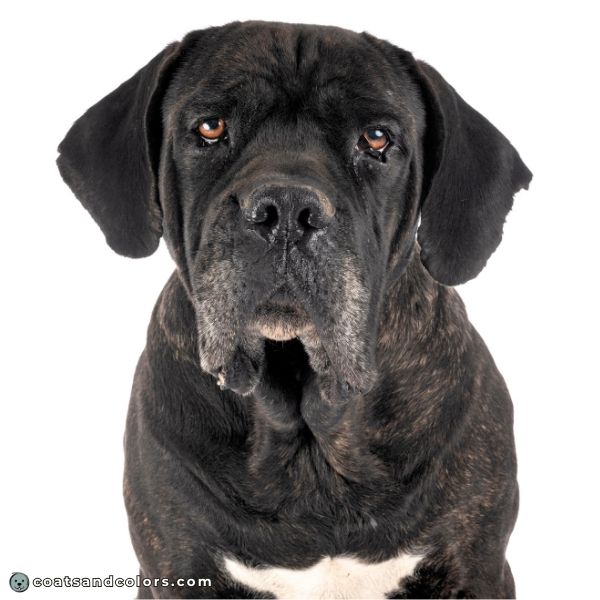

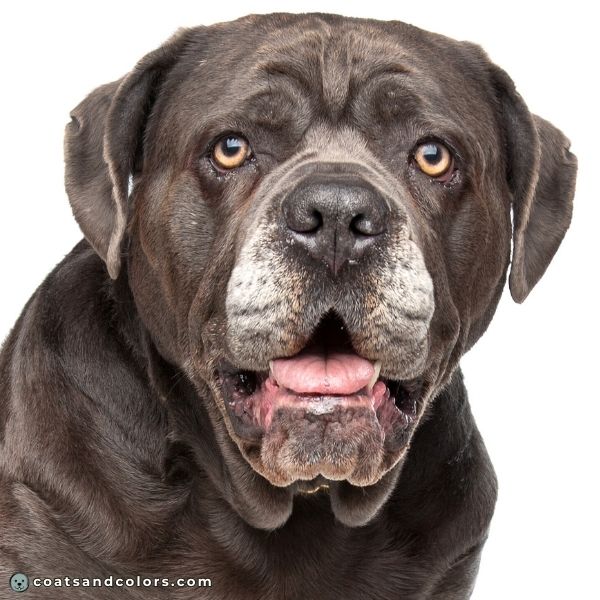
Some young puppies might still have very pale greenish or bluish eyes. This is very normal for young dogs and their eye color will darken over time as more pigment fills in.
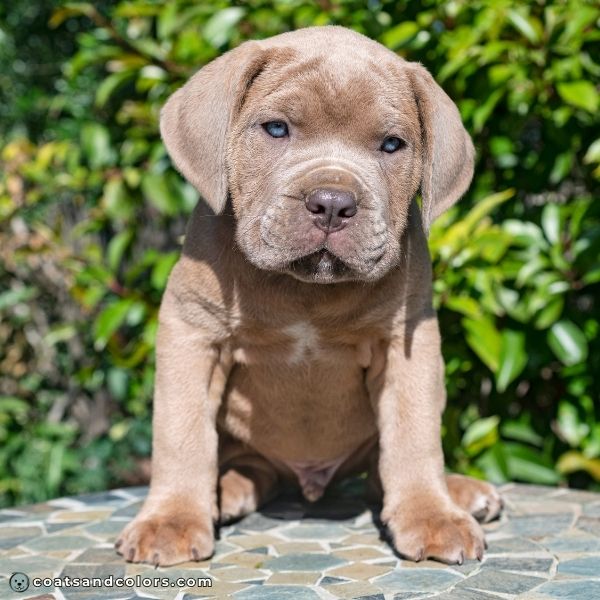
A purebred adult Cane Corso can not have blue eyes since it doesn’t have any of the traits associated with blue eyes in dogs: They neither have enough white on the face nor do they have ALX4 or Merle!
Cane Corso Nose Colors
“Dogs with black pigment have black noses; gray pigmented dogs have gray noses.“
AKC Breed Standard[1]
“Black. A grey mask may have a nose colour of the same nuance.“
FCI Breed Standard[2]
Cane Corso either have a black or diluted black “gray” nose. Their color of eumelanin will also affect the color of their eye rims, lips, paw pads, nails, or whiskers, etc.
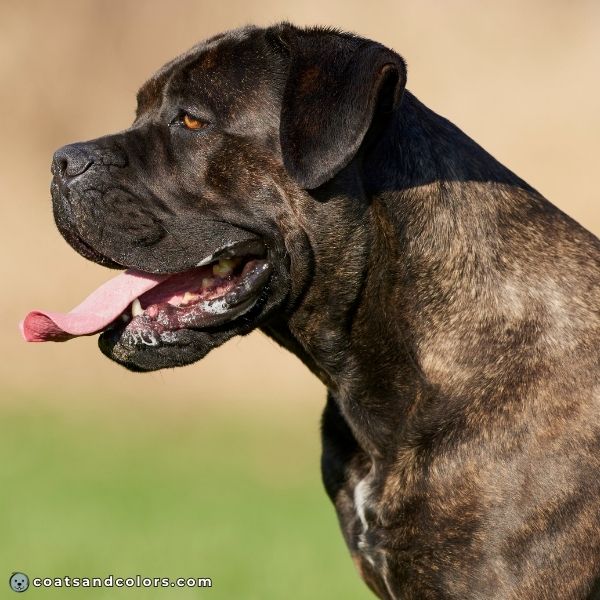
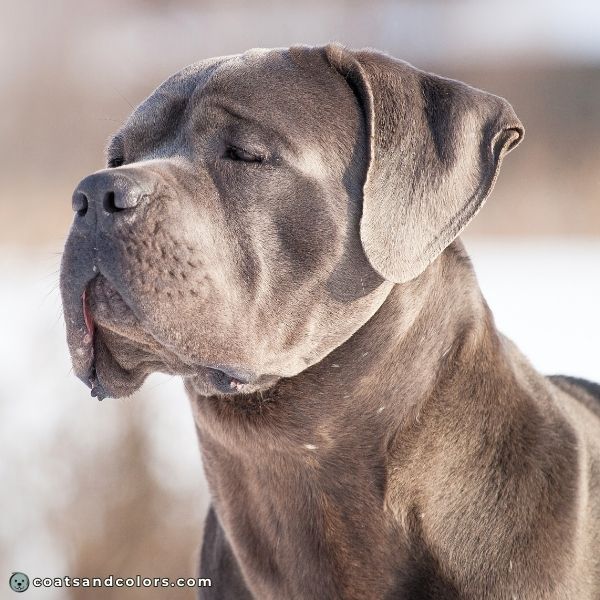
Many dogs with gray pigment have very dark gray noses that can look almost black at first glance.

Cane Corso Non-Standard Colors
Almost all standards list coat colors that are not desirable.
Some out-of-standard coat colors can even disqualify a dog from breeding.
“Disqualification – Any color with tan pattern markings as seen in black-and-tan breeds.”
AKC Breed Standard[1]
“Disqualifying Faults: All colours not indicated in the standard […]”
FCI Breed Standard[2]
But there is a difference between simple mismarks and what I call fancy colors.
- A mismark includes any “faulty” coat color that can happen in the purebred population. These “rare colors” are uncommon because they are often produced by recessive alleles or hidden patterns. This can happen to any breeder and does not necessarily indicate cross-breeding.
- A fancy color, on the other hand, is caused by a coat color trait that was introduced on purpose due to gene flow from another breed. One of the most common examples includes Merle in traditionally non-Merle breeds. Always be wary of breeders who advertise “rare colors” or sell them at a higher price.
These are some non-standard colors of the Cane Corso:
White & Straw Cane Corso
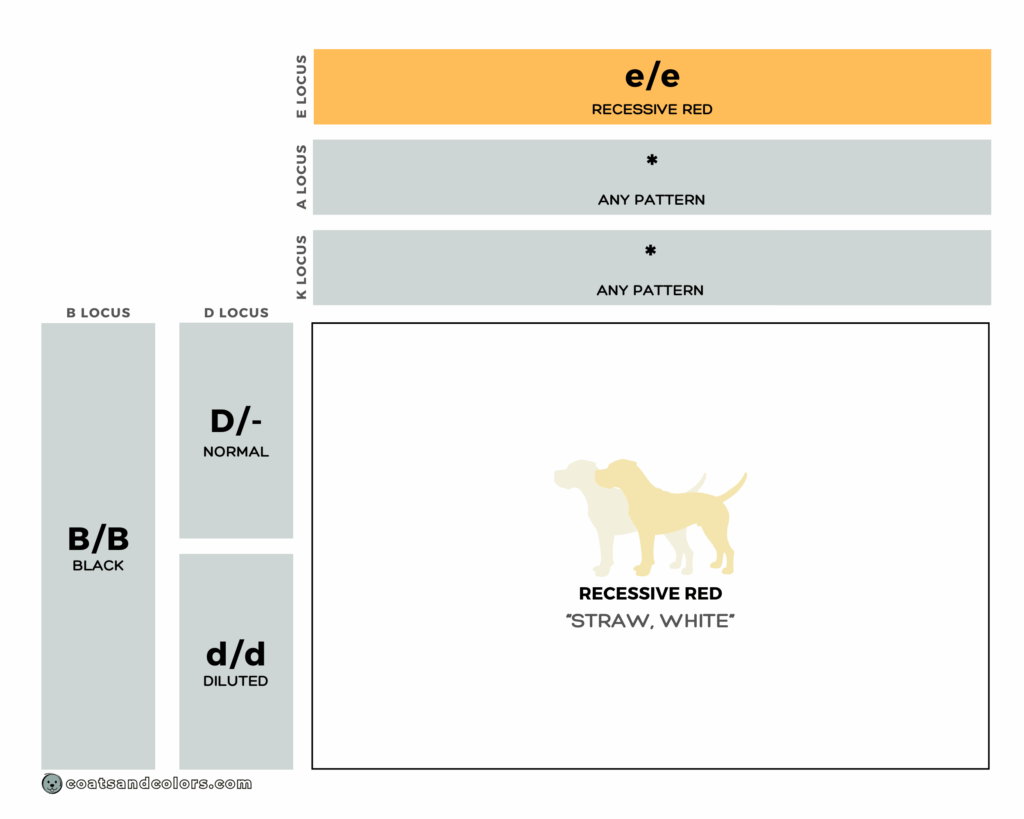
All solid, fawn, or brindle dogs in this breed are supposed to be Em/Em. However, a very small number of Cani Corsi carry the recessive red variant (Em/e). Breeding two carriers can result in some puppies being born with a homozygous e/e genotype which causes them to express recessive red.
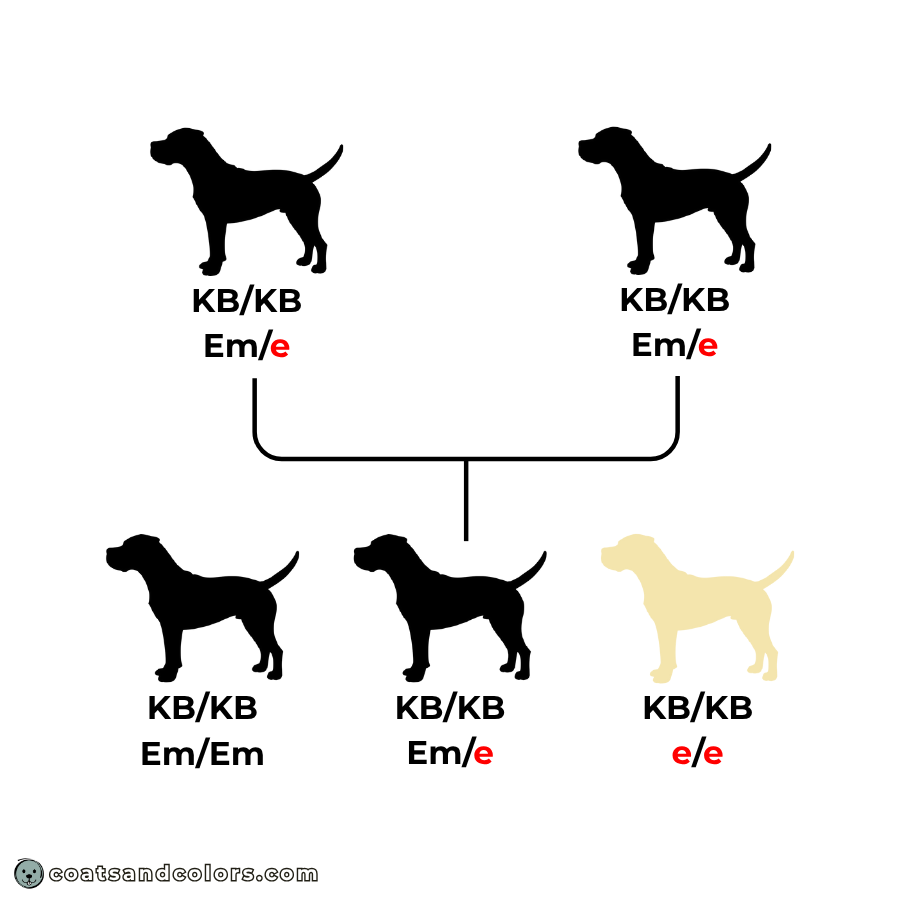
A dog with a recessive red (e/e) pattern can only express phaeomelanin in its coat. Affected dogs will be solid cream or wheaten without a mask or any dark shading. And they always have pale whiskers.
The nose pigment in e/e dogs tends to fade to a pale fleshy color.
The Cane Corso breed term for recessive red is “straw“. A dog with a very pale cream color is sometimes called “white”. This often happens in blue-based recessive red (d/d e/e).
Black & Tan Cane Corso
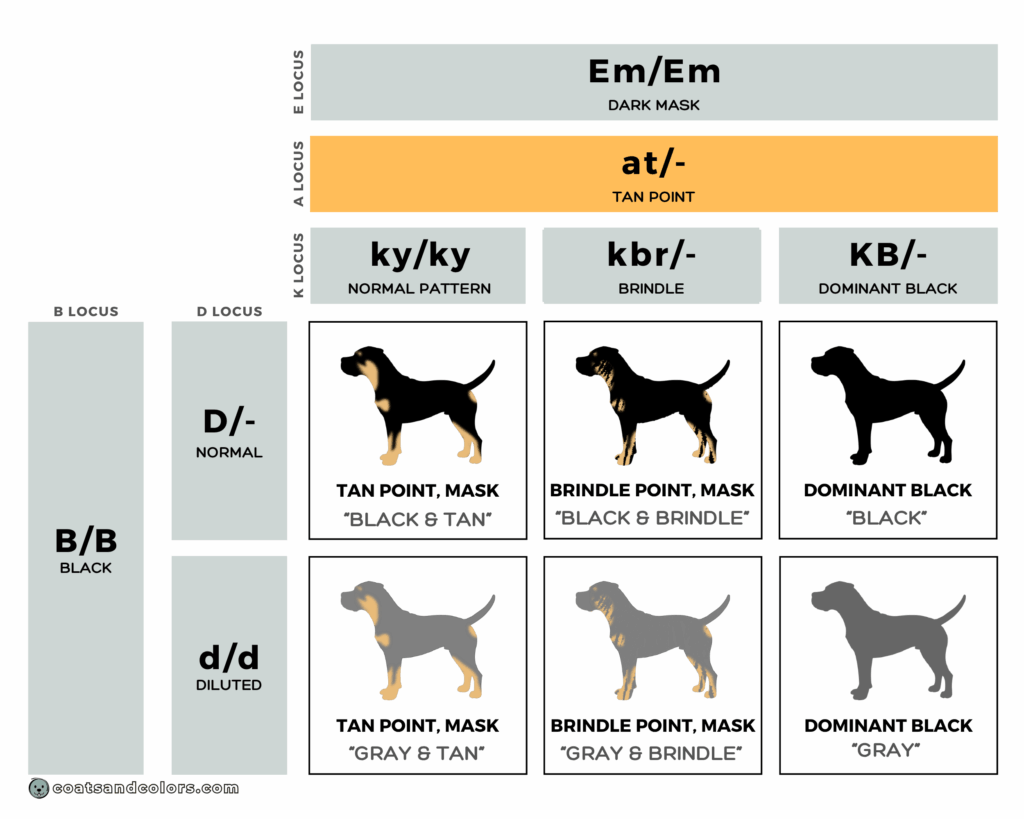
Cane Corso can be black & tan or gray & tan. A faulty pattern they may have borrowed from crossbreeding with Rottweilers during the early days of breed formation.
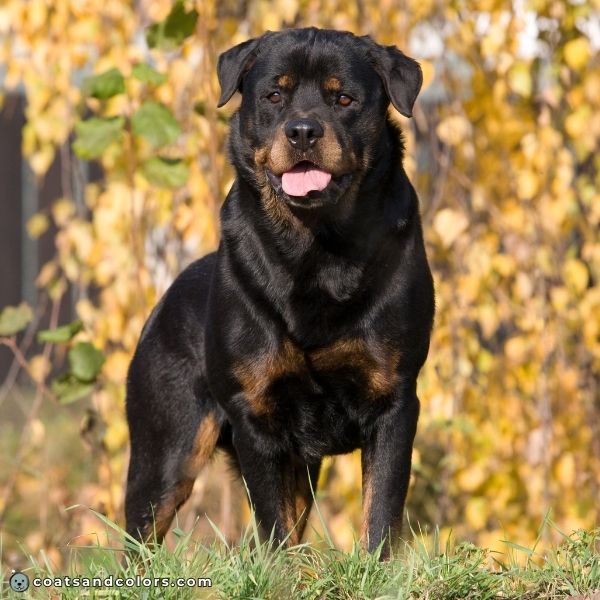
The Cane Corso is supposed to be fixed for a sable pattern at the A locus (Ay/Ay). But quite a few dogs are tan point carriers (Ay/at)[3]. Breeding from two carriers can give tan point puppies (at/at). You can’t see in the phenotype if a fawn or brindle dog is a tan point carrier. A tan point pattern will be hidden in solid dark (KB/- at/at) dogs. The best way to breed away from this pattern is genetic testing.
Tan points will be brindled if they are kbr/- instead of ky/ky. In some cases, very heavy dark brindle point can make the tan point pattern almost disappear because the dog looks solid dark.


A very small number of KB/- at/at dogs might express ghost tan points (incomplete KB over tan points) when viewed in direct sunlight. This seems to be due to the same untestable modifier that causes “seal” (incomplete KB over sable) in some KB/- Ay/- dogs.

Dogs with a tan point pattern and a fair amount of white are called tricolor. A black & tan & white is called a black tricolor, gray & tan & white gives a gray tricolor pattern. Corsi don’t typically have large white markings, this variation of the tan point pattern is more common in color-bred dogs.
Brown & Lilac Cane Corso
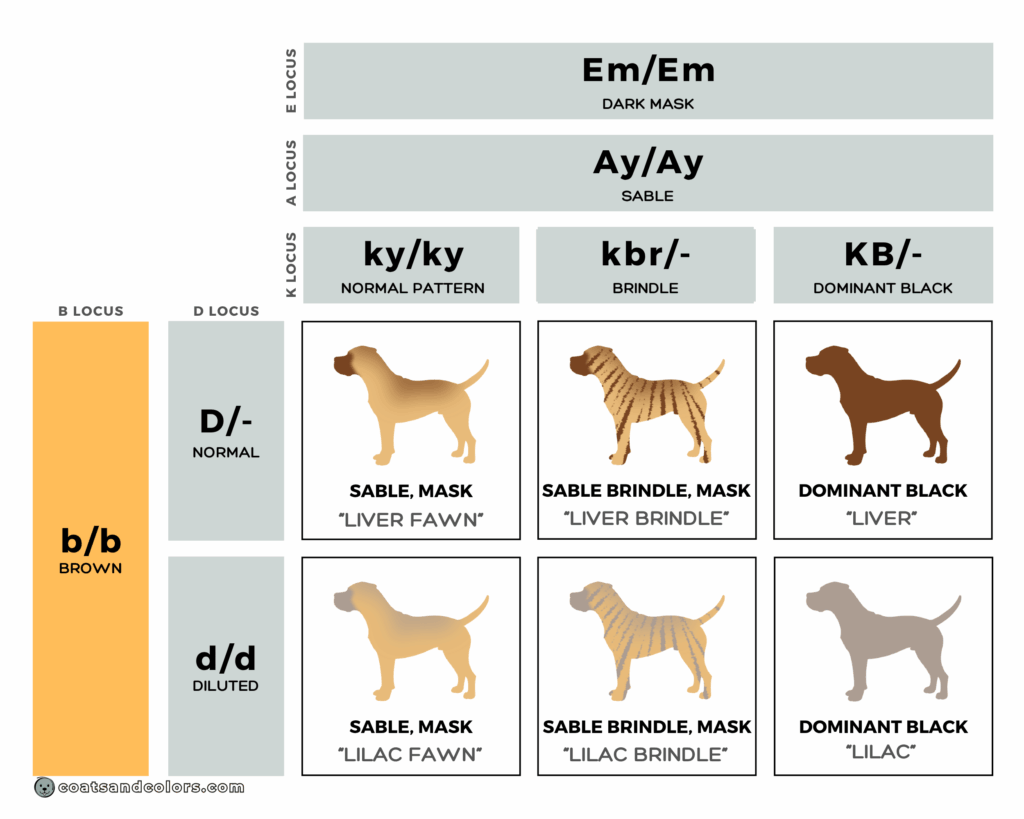
A chocolate brown-based pattern happens when dogs are homozygous for brown eumelanin (b/b).
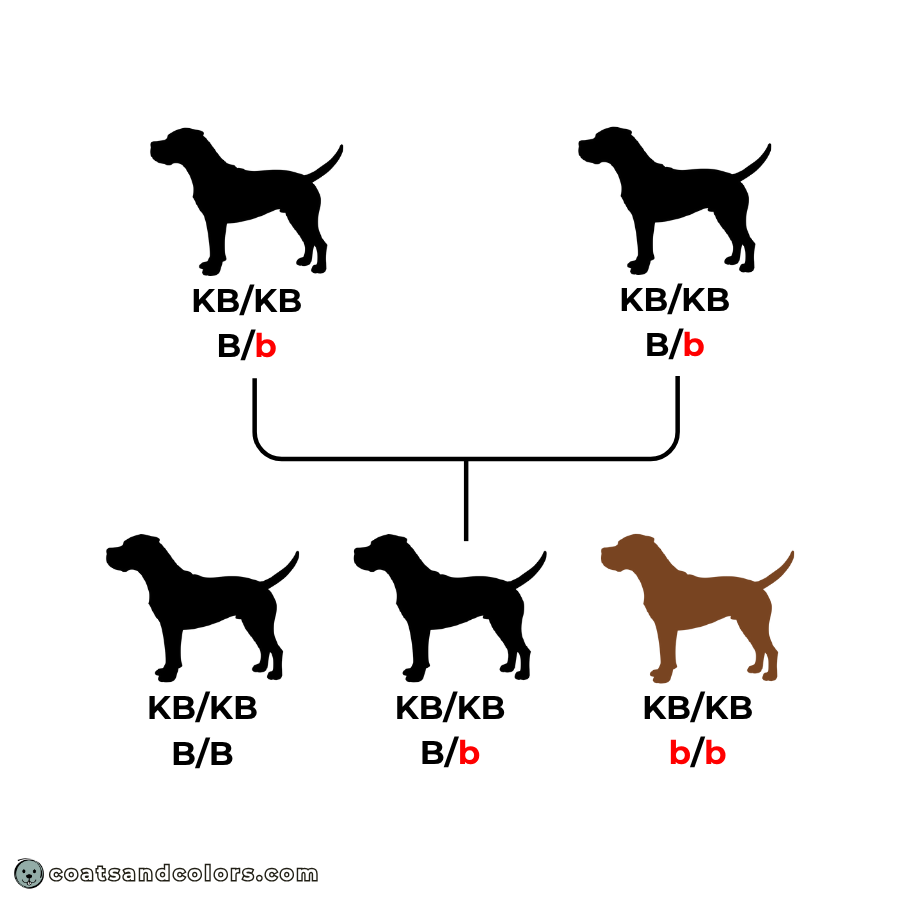
Brown is often called liver or chocolate. It is just a pigment color, it will affect all the eumelanin in any pattern. For example, dogs can be solid liver, chocolate & tan, chocolate brindle, or chocolate fawn. Dogs with brown eumelanin will always have a brown nose and tend to have lighter eyes.
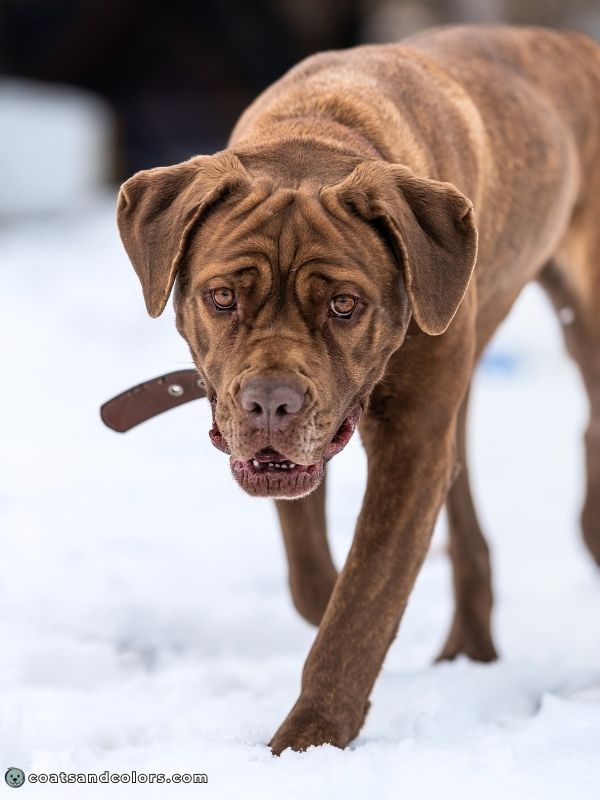
Lilac is diluted brown (b/b d/d). Some call it tawny or isabella. Lilac dogs have a lilac nose and tend to have light eyes. Dogs can have any pattern, e.g. solid lilac, lilac brindle, lilac fawn, or lilac & tan.
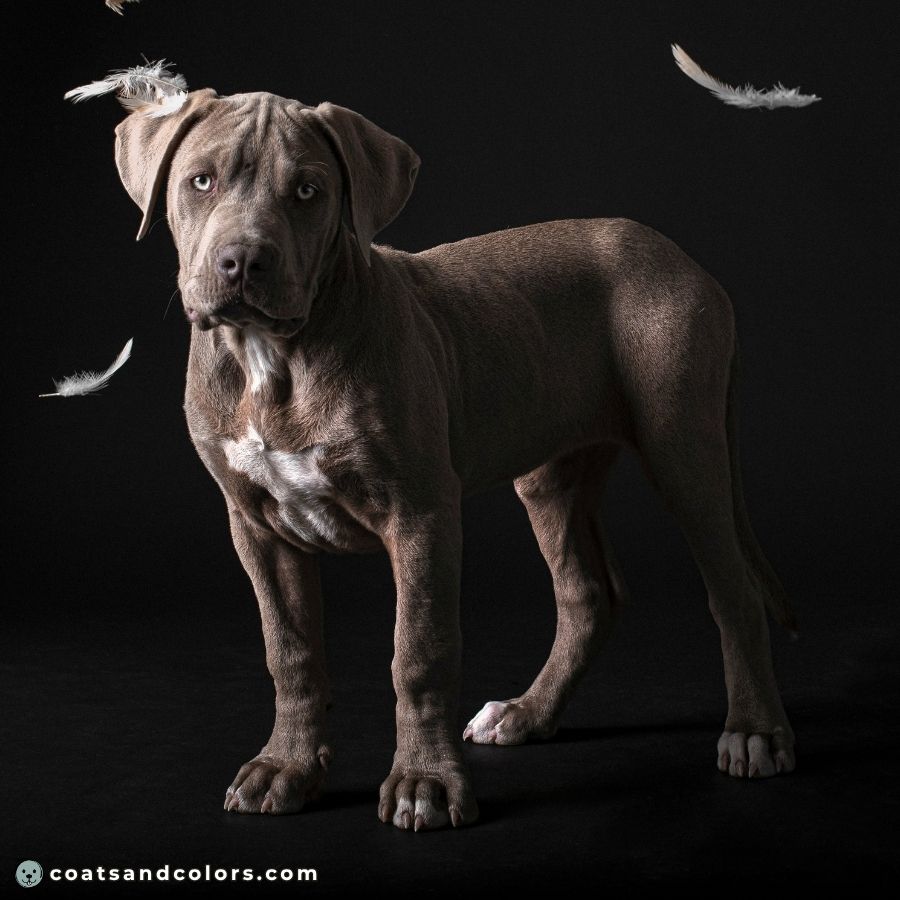
Missing Masks
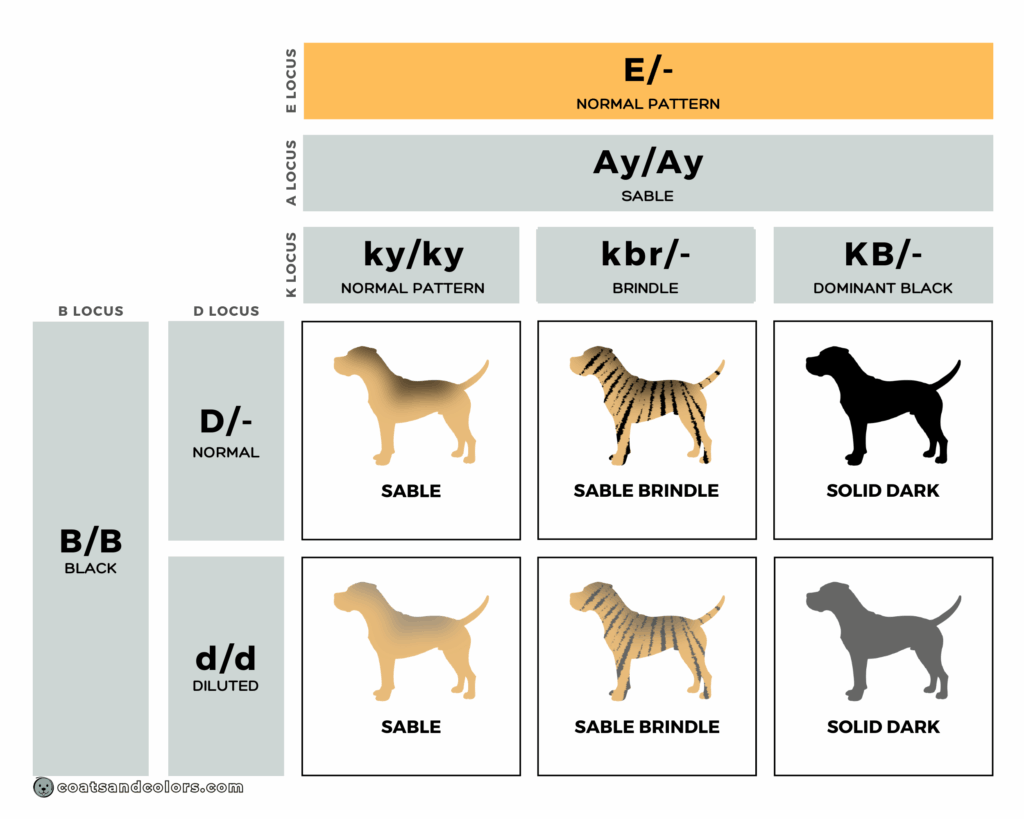
Cane Corso in sable or brindle can be maskless (Ay/- ky/ky or kbr/- E/E or E/e). The allele frequency for the wild type E allele was reported at about 6% in a small sample of tested dogs[3].
The E allele is recessive to the Em allele. Any dog with a mask can be carrier for maskless (Em/E). And the presence of a mask is invisible in solid dark dogs. You can’t see if a solid black or gray Cane Corso is Em/Em, Em/E, or E/E. Pairing two dogs that can each give E can result in E/E puppies.

Merle Cane Corso
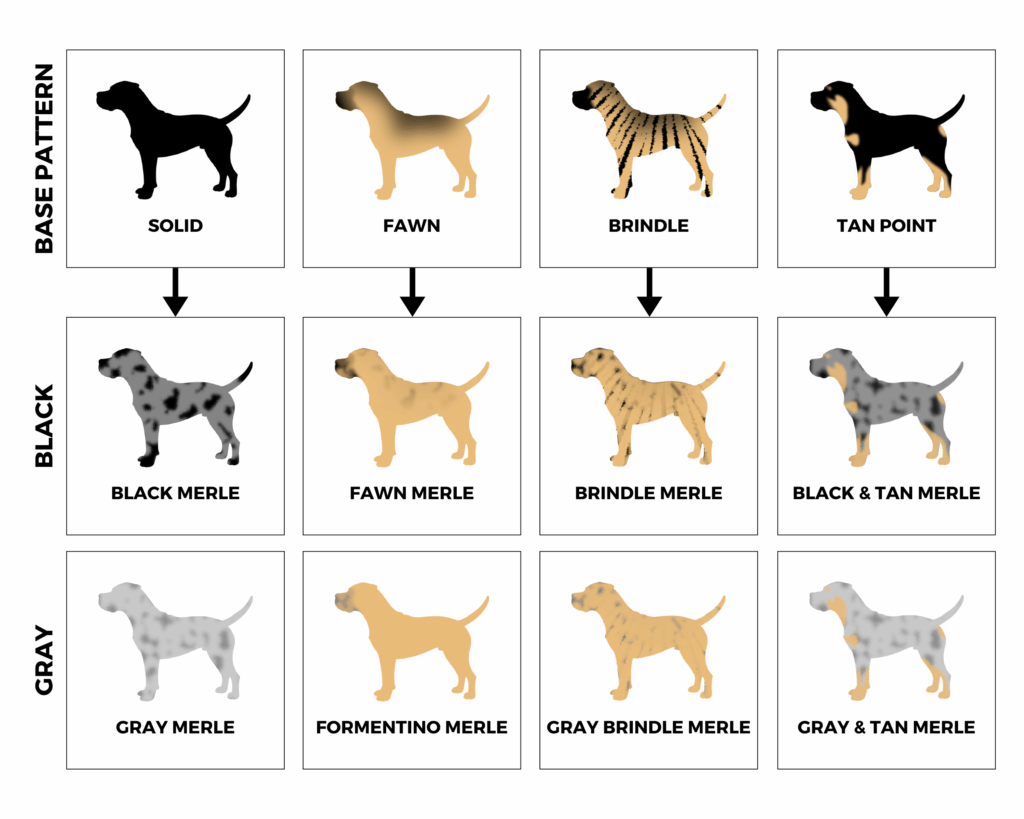
The Cane Corso is not one of the traditional Merle breeds. This dominant trait has been introduced only recently via cross-breeding. In other words, a Merle Cane Corso can’t be purebred.
Classic Merle removes some of the eumelanin from a pattern. This leaves random patches of the original color and merled areas with lighter shades. Phaeoemelanin will be less affected. The final phenotype depends on the individual base pattern (solid, brindle, fawn, …) and pigment colors.
Learn More
Links
[1] American Kennel Club (AKC): Cane Corso
[2] Fédération Cynologique Internationale (FCI): Cane Corso
[3] Dreger et al. (2019). True Colors: Commercially-acquired morphological genotypes reveal hidden allele variation among dog breeds, informing both trait ancestry and breed potential. PLoS ONE 14(10): e0223995. https://doi.org/10.1371/journal.pone.0223995
[4] Modern Molosser
[5] Cane Corso Association of America (CCAA): “Rare” Colors In The Cane Corso
Image Credits
© dpcrestock/yayimages.com
© cynoclub/yayimages.com
© Lincikas/yayimages.com
© Eudyptula/canva.com
© eriklam/yayimages.com
© Rocco Stoppoloni/pexels.com
© Kurt Pas/canva.com
© DevidDO/canva.com
© slowmotiongli/canva.com
© Grekov/canva.com
© Grisha Bruev/canva.com
© Mary Swift/canva.com
© YuriyGreen/canva.com
© Ilona Didkovska/canva.com
© Olha Ivanchenko/canva.com
© janpla01/canva.com
© vauvau/canva.com
© eriklam/canva.com
© sbolotova/depositphotos.com
© Eleonora Maltempi/unsplash.com
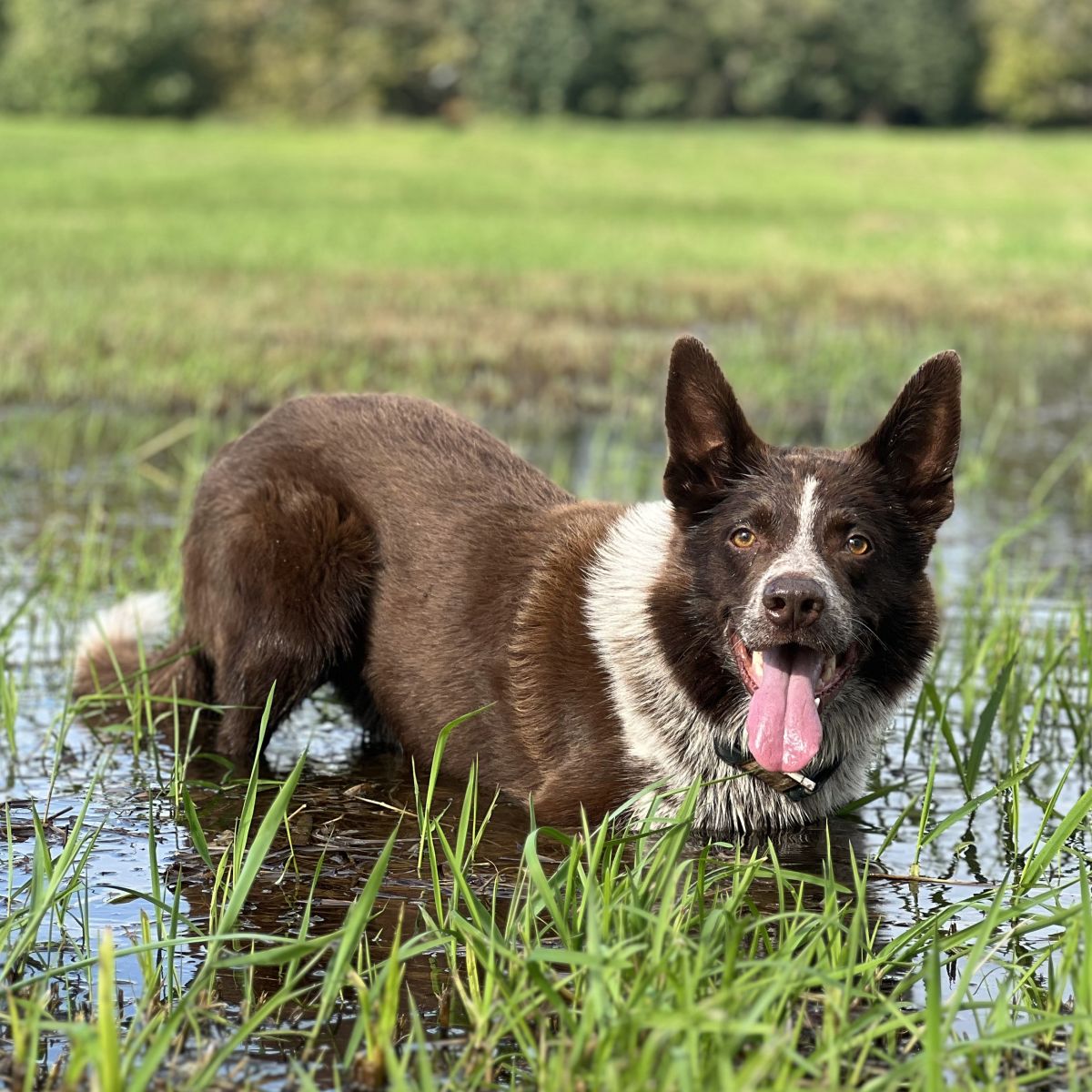
Hi! I’m Steffi. I am a biologist and a big time dog nerd. You are curious about coat color genetics? You’ve come to the right place! Read more.



